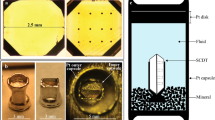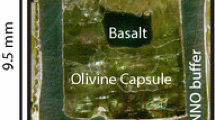Abstract
Here, we present the first analytical technique (the quartz tube system technique—QTS) to directly analyze H2O and CO2 contents in liquids following high-pressure, high-temperature experiments in capsules containing mantle minerals and a diamond layer serving as a fluid/melt trap. In this technique, the capsule is frozen prior to opening; the diamond trap is cut out of the capsule and placed inside a N2-filled quartz tube. The diamond trap is heated up to 900 °C to release the gases to an Infrared Gas Analyzer, which determines the CO2 and H2O contents. Three sets of experiments containing SiO2 and CaCO3 powders were performed at 6 GPa and 1,000 °C in order to calibrate and validate the technique. These experiments demonstrated that when samples are prepared in a N2 environment, CO2 and H2O can be directly measured with an accuracy and precision of 2–3 and 3–4 %, respectively. The QTS technique (for H2O and CO2 determination) together with the cryogenic technique (total dissolved solids content) can be applied to diamond-trap capsules following HP–HT experiments in order to provide direct and complete liquid compositions coexisting with mantle material. The principal advantage of the QTS technique of direct analysis of volatile content in liquids over the indirect approach of mass balance calculations is the possibility of studying carbonated and hydrous liquid compositions in equilibrium with mantle material regardless of chemistry and pressure–temperature experimental conditions.


Similar content being viewed by others
References
Baker MB, Stolper EM (1994) Determining the composition of high pressure mantle melts using diamond aggregates. Geochim Cosmochim Acta 58:2811–2827
Brey GP, Green DH (1975) The role of CO2 in the genesis of olivine melilite. Contrib Miner Petrol 49:93–103
Dasgupta R, Hirschmann MM, Smith ND (2007) Partial melting experiments of peridotite CO2 at 3 GPa and genesis of alkalic ocean island basalts. J Petrol 48:2093–2124
Dvir O, Pettke T, Fumagalli P, Kessel R (2011) Fluids in the peridotite-water system up to 6 GPa and 800 °C: new experimental constrains on dehydration reactions. Contrib Miner Petrol 161:829–844
Eggler DH (1978) The effect of CO2 upon partial melting of peridotite in the system Na2O–CaO–Al2O3–MgO–SiO2–CO2 to 35 Kb with an analysis of melting in a peridotite-H2O–CO2 system. Am J Sci 278:305–343
Eggler DH, Baker DR (1982) Reduced volatiles in the system C–O–H: implications to mantle melting, fluid formation, and diamond genesis. In: Akimoto S, Manghnani MH (eds) High-pressure research in geophysics. Center for Academic Publications Japan, Tokyo, pp 237–250
Falloon TJ, Green DH (1989) The solidus of carbonated, fertile peridotite. Earth Planet Sci Lett 94:364–370
Falloon TJ, Green DH (1990) Solidus of carbonated fertile peridotite under fluid-saturated conditions. Geology 18:195–199
Green DH, Wallace ME (1988) Mantle metasomatism by ephemeral carbonatite melts. Nature 336:459–462
Hirose K (1997) Partial melt compositions of carbonated peridotite at 3 GPa and role of CO2 in alkali-basalt magma generation. Geophys Res Lett 24:2837–2840
Izraeli ES, Harris JW, Navon O (2001) Brine inclusions in diamonds: a new upper mantle fluid. Earth Planet Sci Lett 187:323–332
Kessel R, Ulmer P, Pettke T, Schmidt MW, Thompson AB (2004) A novel approach to determine high-pressure, high-temperature fluid and melt compositions using diamond-trap experiments. Am Miner 89:1078–1086
Kessel R, Ulmer P, Pettke T, Schmidt MW, Thompson AB (2005) The water basalt system at 4 to 6 GPa: phase relations and second critical endpoint in a K-free eclogite at 700 to 1400 °C. Earth Planet Sci Lett 237:873–892
Klein-BenDavid O, Izraeli ES, Hauri E, Navon O (2004) Mantle fluid evolution, a tale of one diamond. Lithos 77:243–253
Klein-BenDavid O, Pettke T, Kessel R (2011) Chromium mobility in hydrous fluids at upper mantle conditions. Lithos 125:122–130
Kushiro I, Hirose K (1992) Experimental determination of composition of melt formed by equilibrium partial melting of peridotite at high pressures using aggregates of diamond grains. Proc Japan Acad Ser B Phys Biol Sci 68:63–68
Leost I, Stachel T, Bre GP, Harris JW, Ryabchikov ID (2003) Diamond formation and source carbonation: mineral associations in diamonds from Namibia. Contrib Miner Petrol 145:15–24
Luth RW, Virgo D, Boyd FR, Wood BJ (1990) Ferric iron in mantle derived garnets: implications for thermobarometry and for the oxidation state of the mantle. Contrib Miner Petrol 104:56–72
Navon O, Hutcheon ID, Rossman GR, Wasserburg GJ (1988) Mantle-derived fluids in diamond micro-inclusions. Nature 335:784–789
Poli S, Schmidt MW (2002) Petrology of subducted slabs. Annu Rev Earth Planet Sci 30:207–235
Poli S, Franzolin E, Fumagalli P, Crottini A (2009) The transport of carbon and hydrogen in subducted oceanic crust: an experimental study to 5 GPa. Earth Planet Sci Lett 278:350–360
Schmidt MW, Poli S (1998) Experimentally based water budgets for dehydrating slabs and consequences for arc magma generation. Earth Planet Sci Lett 163:361–379
Schmidt MW, Ulmer P (2004) A rocking multianvil: elimination of chemical segregation in fluid-saturated high-pressure experiments. Geochim Cosmochim Acta 68:1889–1899
Schrauder M, Navon O (1994) Hydrous and carbonatitic mantle fluids in fibrous diamonds from Jwaneng, Botswana. Geochim Cosmochim Acta 58:761–771
Smith D (1987) Genesis of carbonate in pyrope from ultramafic diatremes on the Colorado Plateau, southwestern United States. Contrib Miner Petrol 97:389–396
Stalder R, Ulmer P, Thompson AB, Günther D (2001) High pressure fluids in the system MgO–SiO2–H2O under upper mantle conditions. Contrib Miner Petrol 140:607–618
Stalder R, Ulmer P, Günther D (2002) Fluids in the system forsteritephlogopite-H2O at 60 kbar. Schweiz Miner Petrol Mitt 82:15–24
Stockhert B, Duyster J, Trepmann C, Massonne HJ (2001) Microdiamond daughter crystals precipitated from supercritical COH plus silicate fluids included in garnet, Erzgebirge, Germany. Geology 29:391–394
Tomlinson EL, Jones, AP, Harris JW (2006) Co-existing fluid and silicate inclusions in mantle diamond. Earth Planet Sci Lett 250:581–595
Truckenbrodt J, Johannes W (1999) H2O loss during piston-cylinder experiments. Am Miner 84:1333–1335
Truckenbrodt J, Ziegenbein D, Johannes W (1997) Redox conditions in piston-cylinder apparatus: the different behavior of boron nitride and unfired pyrophyllite assemblies. Am Miner 82:337–344
Ulmer MP, Cruddace RG, Fenimore EE, Fritz GG, Snyder WA (1987) SPARTAN 1 X-ray observations of the Perseus cluster—comparison of the iron abundances and temperatures in the inner and outer regions of the clusters. Astrophys J 319:118–125
Wang A, Pasteris JD, Meyer HOA, Dele-Duboi ML (1996) Magnesite bearing inclusion assemblage in natural diamond. Earth Planet Sci Lett 141:293–306
Yaxley GM, Green DH (1994) Experimental demonstration of refractory carbonate-bearing eclogite and siliceous melt in the subduction regime. Earth Planet Sci Lett 128:313–325
Acknowledgments
This work received support by Israel Science Foundation Grants 251/09 (RK) and 870/08 (AA), and Ring Foundation grant (AA). We thank R. Dasgupta and an anonymous reviewer for their useful comments of this version of the manuscript.
Author information
Authors and Affiliations
Corresponding author
Additional information
Communicated by T. L. Grove.
Rights and permissions
About this article
Cite this article
Dvir, O., Angert, A. & Kessel, R. Determining the composition of C–H–O liquids following high-pressure and high-temperature diamond-trap experiments. Contrib Mineral Petrol 165, 593–599 (2013). https://doi.org/10.1007/s00410-012-0825-6
Received:
Accepted:
Published:
Issue Date:
DOI: https://doi.org/10.1007/s00410-012-0825-6




